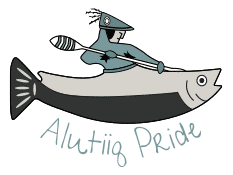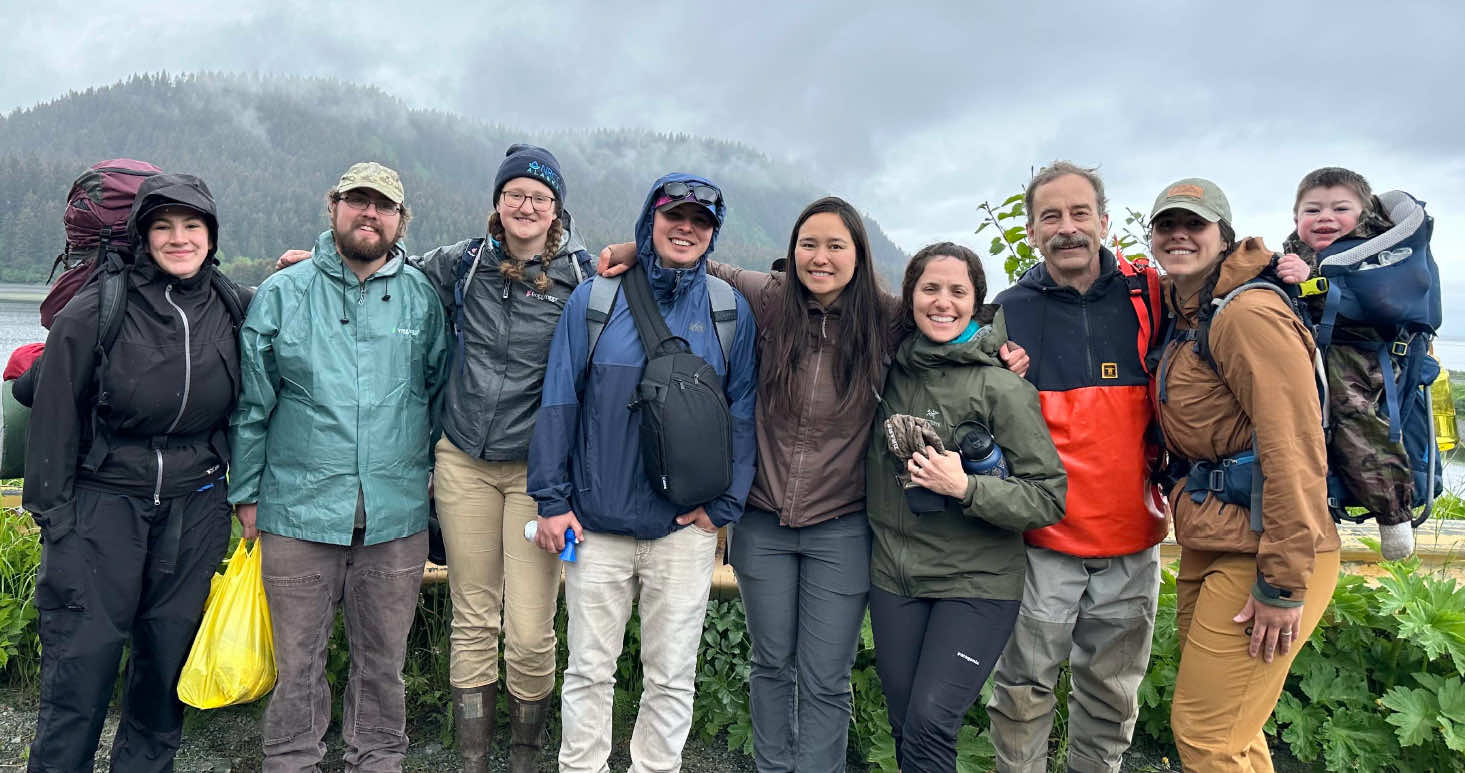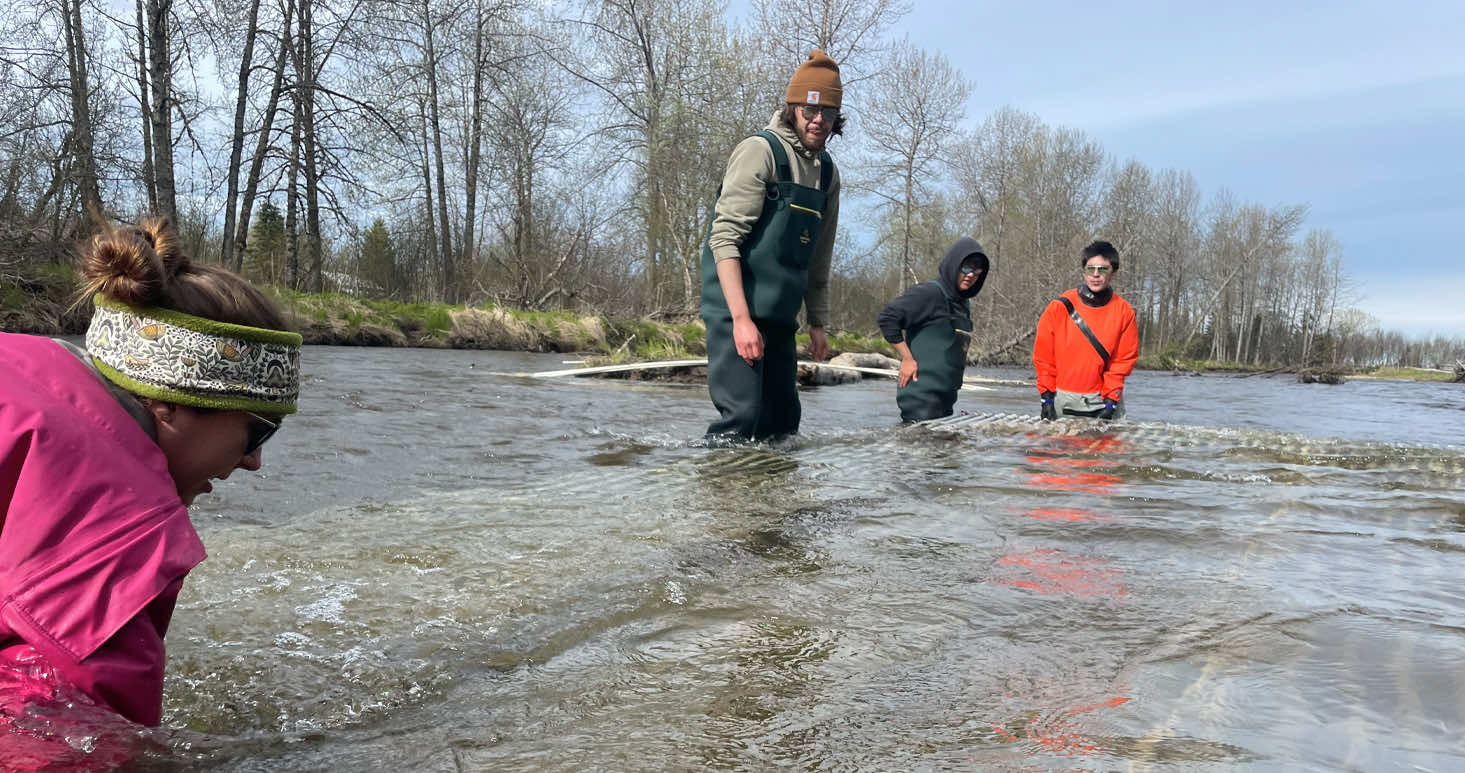CRRC 2021 Q2 Newsletter

Chugach Regional
Resources Commission Quarterly Update
CRRC has been busy these last few months! Take a look below to see what staff have been up to. We also include other regional and noteworthy news.
Chugach Regional Resources Commission is excited to welcome two new employees, Tanja and Allison! Please read more about these rockstars below👩🎤👩🎤.
Allison Carl
Born and raised in Anchorage and is currently finishing her B.S. in biological sciences at University of Alaska Anchorage. A partnership between Chugach Alaska Corporation (CAC) and Chugach Regional Resources Commission (CRRC) has allowed Allison to finish the CAC internship program as CRRC’s new Research Scientist Intern. Her educational and career interests include water and food security in Alaskan communities. During her down time, Allison enjoys spending time at local parks and trails around the Anchorage area.
Tanja Davis
Specializing in Cost and Project Controls in various industries since 1993 to include the International Business sector and overseeing large scale import and export activities for multiple manufacturing industries in Germany as well as the United States. Ms Davis joined Chugach Regional Resources in December 2021 and is responsible for cost controls, analysis and management, reporting and billing. In her free time, she enjoys the outdoors, riding horses and motorcycles, skiing, ice skating and playing table tennis. Tanja came to Alaska from New Orleans in 2010 to join her son and grandson and to welcome her granddaughter in 2012.
CRRC is Developing a Bird ID Guide
and Ethnography
CRRC has funding to develop a migratory bird identification guide and ethnography for the Chugach Region. The spring migratory bird and egg harvest are traditionally an important source of early fresh food in the spring, but much of the Indigenous knowledge has not been passed down through the generations. The goal is to raise awareness of migratory birds, both as a traditional source of food and their role in the local ecosystems and subsistence seasonal rounds.

Wisdom Keepers Wanted!
Register for this event here
Spring and summer hunting of birds was illegal for nearly 80 years under the Migratory Bird Treaty Act, until the Act was amended to allow for rural Alaskan residents to hunt birds and gather eggs in spring. Since the Migratory Bird Treaty Act was amended to allow for traditional spring harvests, there’s been an increase in interest in participating in egging and bird hunting activities, especially among younger people who don’t always have someone to teach them about birds. Our goal is to share knowledge about spring egging and bird hunting in Southcentral Alaska between communities and between generations.
Join us online or on the phone for a two-day workshop that will share knowledge about migratory bird hunting, egging, and traditional management between elders and youth, and between communities from around Southcentral. These two days will feature:
– Talking circles for elders and youth
– A live bird demonstration from Bird TLC and nature drawing class taught by Homer-based artist Kim McNett
– A lunchtime screening of the film The Duck In, about Utqiagvik’s civil disobedience protest against the Migratory Bird Treaty Act
– Representatives from the AMBCC, Alaska Department of Fish and Game, and the US Fish and Wildlife Service to answer questions
Chugach Regional Resources Commission is developing a Southcentral Migratory Bird Harvest Pocket Guide and would like to commission an artist from the Chugach region to develop the cover of the publication. We are requesting a portfolio and a concept description for avian-related illustrations, paintings, mixed-media, etc. The CRRC Board of Directors and staff will be voting on the winners and the final product is due to CRRC on June 30, 2021. See the flyer for more details.

- How Do You Subsist in the CRRC region – Show us the plants and animals that keep your traditions alive!
- CRRC Communities – Tell us the visual stories of the CRRC communities.
- Sweeping Views – As you explore trails, and hike to the tops of the steep mountains capture those impressive landscapes!
- A Closer Look – Find the little details that make the CRRC region what it is.
Winners will be announced by May 31, 2021


The Science Director, Maile Branson and the Regional Environmental Coordinator, Chelsea Campbell presented at the Kachemak Bay Science Conference, hosted from March 15-18, 2021.
Maile Branson presented at the Kachemak Bay Science Conference as both a panelist for a live community scientific discussion on harmful algal blooms, their biology, and current monitoring and detection methods. She also presented on the CRRC and APMIs new Chugach Regional Ocean Monitoring Program, a comprehensive biotoxin, phytoplankton, and water chemistry monitoring throughout southcentral Alaska.
Chelsea Campbell presented on the Community Sampling for Ocean Acidification in Southcentral Alaska Video and the Interim Water Quality Report Poster CRRC created on the first year water quality data. The video, produced by Southern Dipper Productions, features staff from APMI discussing what ocean acidification is and how it impacts local natural resources. The video also features Tribal Members from Seldovia Village Tribe and the Native Village of Port Graham discussing the importance and protocols of proper water quality sampling.
Both Maile and Chelsea attended the panel sessions from 12pm-1pm on their respective presentation days. During the panel sessions, participants had the opportunity to ask the presenters questions regarding their presentations and have real-time discussions about their work.
Chugach Regional Resources Commission (CRRC) received a grant from the Center for Disease Control to promote health and wellbeing in our communities. The COVID-19 pandemic is causing significant disruptions in availability of food in our communities, and as such, CRRC has been shifting the focus of our organization to assist communities dealing with the immediate impacts to food security from COVID-19. With generosity of the Alaska Native Tribal Health Consortium’s Traditional Food Guide for the Alaska Native People, CRRC has been able to include nutrition facts of cherished subsistence foods, when available. One thing is certain: without access to healthy foods, Tribal members, particularly for those at risk of, or suffering from food insecurity and those with pre-existing non-communicable diseases who are at a heightened risk of becoming severely ill with the COVID-19 Virus.
Traditional Foods Recipes


On March 10, 2021, Executive Director, Willow Hetrick and Science Director, Maile Branson presented at a Webinar Series titled: Managing Harmful Algal Blooms in Tribal Waters. This was a collaborative series hosted by U.S. EPA, the Sitka Tribe of Alaska and NOAA. Willow and Maile were part of a panel series titled: Experiences Managing and Communicating Harmful Algal Bloom Risks.

Our region, although not as populated, rely heavily on subsistence foods in their diets and as such, have a high need for toxin analysis. In addition to the increasing scarcity of shellfish foods on beaches used by Tribal members from this pressure, we now have to counteract the growing concerns of potential PSP and HAB events.
The Alutiiq Pride Marine Institute received funding from the Administration of Native Americans to become the southcentral center of processing and analyzing harmful algal bloom and paralytic shellfish poisoning samples for Tribes and other organizations as well. Once there are regional harmful algal bloom monitoring efforts, we can link together to form Statewide Tribal program designed to ensure all beaches and animals are safe for consumption. This type of co-management is successful on many endeavors in the native community.
The Objectives and Outcomes of this grant funding include safe shellfish harvest for all stakeholders (subsistence, mariculture, and recreational users), collection of baseline coastal marine conditions in Prince William Sound and Lower Cook Inlet and eventually, harmful algal bloom precipitating factors and forecasts.
Community Sampling for Ocean Acidification
in Southcentral Alaska Video
Chugach Regional Resources Commission was awarded through the 1st OA Information Exchange microgrants by Ocean Acidification Information Exchange and used the funds to create an educational video that can be used to help inform native Alaskan communities about the threat ocean acidification poses to local wild shellfish populations. The ocean acidification monitoring by APMI provides climate data for researchers to utilize in studying trends and high-level science.
This video features Natural Resource Specialists from Native Village of Port Graham and the Seldovia Village Tribe, who have been building their capacities for years to manage local environmental protection programs. Utilizing local residents to conduct the sampling is a cost-effective way to expand the spatial ocean acidification dataset coverage, build capacity in those communities and broaden the local knowledge for residents most affected by changing ocean conditions.


Chugach Regional Resources Commission’s Regional Environmental Sampler, Chelsea Campbell, and Alutiiq Pride Marine Institute’s Ocean Acidification Lab Manager, Jacqueline Ramsay, hosted a virtual two-day Water Quality Sampling Training on March 9th and 10th, 2021. The training was geared toward new Environmental Samplers in the Chugach Region, however veteran Samplers attended the training as a refresher on proper sampling techniques. Over the course of the two days, CRRC had over 15 participants from Tribes in lower Cook Inlet and Prince William Sound.
CRRC and APMI recognizes the importance of providing new and refresher sampling trainings for our Member Tribe’s Environmental Samplers. CRRC’s Water Quality Monitoring Program has been running for five years and in that time has trained numerous samplers from villages in the Chugach Region and beyond. The success of the program is in large part because of our dedicated Environmental Samplers who take the time and patience to learn proper sampling techniques.
Alaska Marine Science Symposium
Maile Branson, the Science Director for the Alutiiq Pride Marine Institute, presented at the Alaska Marine Science Symposium on January 26-28, 2021.
Shellfish populations in southcentral Alaska have experienced a continual decline over the last two decades with no evidence of recovery. The loss of this resource has had a dramatic effect on food security for Alaska native communities who heavily rely on shellfish as an integral part of their diet and traditional lifestyle. The absence of shellfish also affects the complex nutrient cycling of beaches, diminishing the basic productivity of nearshore intertidal regions. Establishment of management plans to both study and restore shellfish habitats within local subsistence use areas are crucial to maintain healthy clam populations. This project seeks to engage in the establishment of native shellfish sanctuaries throughout several intertidal habitats in southcentral Alaska. These sanctuaries will be used to 1) monitor the growth of seeded shellfish in situ and 2) re-establish healthy native populations for future subsistence use.
This is a collaborative project led by regional Tribes in southcentral Alaska and supported by the Alutiiq Pride Shellfish Hatchery, a division of the Chugach Regional Resources Committee. In addition to scientific efforts, a major goal of this program is the involvement of trained Tribal members as citizen scientists. All beach surveys, juvenile out-plantings, and monitoring efforts will be conducted at the local level to ensure the efficacy of future Tribally led shellfish programs. The data collected during this project will be used 1) to enhance the current body of scientific knowledge with respect to shellfish growth and 2) in the development of local shellfish management plans. This project improves fish and wildlife management capabilities through training opportunities with Tribal Members, and allows the Tribes to regain traditional self-sufficiency. Successful development of this program will facilitate the potential application of this method to other coastal Tribal communities that are dependent on shellfish as a traditional subsistence food source.
Alaska Marine Science Symposium

- PROPOSAL 2021 –01 – to 1) specify that subsistence harvest areas designated for specific communities are open to hunting including any portions that occur within an excluded area, and 2) clarify language defining excluded areas.
- PROPOSAL 2021 –02 – to clarify boundary definitions for the harvest areas designated for the communities of Port Graham and Nanwalek (Gulf of Alaska region), and for the community of Tyonek (Cook Inlet region). Current harvest area definitions in the CFRs for these communities are incomplete (i.e., do not describe a complete polygon), and the partially defined boundaries of the harvest areas are difficult for hunters and law enforcement officers to interpret.
- PROPOSAL 2021-03 – defines several excluded areas that are closed to harvest, but for two of these excluded areas the definitions are vague. The Kenai Peninsula roaded area and the Gulf of Alaska roaded area are not defined with any specific boundaries. This proposal seeks to clarify the boundaries of these areas.
for National Book
The Alaska Migratory Bird Co-Management Council (AMBCC) Executive Director Patty Schwalenberg was invited by the Subsistence Division of the Alaska Department of Fish & Game (ADF&G) to co-author a chapter of a book on Tribal Wildlife Management. The book project is being led by Steve Albert of the Institute for Bird Populations and Serra Hoagland, U.S. Department of Agriculture (USDA), in partnership with the Southwest Tribal Fisheries Commission, who also serve as the editors. The working title of the book is “Wildlife Management on Tribal Lands” and the working title for the chapter ADF&G will be focusing on is “Indigenous Participation in Co-Management of Subsistence Harvest of Migratory Birds in Alaska.”
Currently, funding is being sought to support the integration of interviews with the founders of the AMBCC and those that were instrumental in amending the Migratory Bird Treaty Act, including representatives from the three AMBCC partners — Alaska Native Caucus, USFWS, and the ADF&G. Funding is intended to provide support for honoraria and travel expenses, if feasible, depending on the status of the pandemic in mid-2021. The chapter and other chapters in the book will include short interviews, original artwork, and oral histories from elders that are knowledgeable about traditional wildlife conservation practices.
Participating in this book project will also assist in fulfilling an information and documentation gap at the AMBCC. Partners have been requesting historic documentation that could help with the transmission of institutional knowledge as the turnover of Native, federal, and state partners occur over time. Documenting the history of the AMBCC will also assist in clarifying AMBCC objectives, achievements, needs, and actions to fulfill identified needs. Most importantly, participating in this project contributes to co-management as a broad concept and will portray all partners’ perspectives in the co-management process embraced by the AMBCC.


Potential impacts:
- Because rats have a very broad diet, they can have a harmful affect on many different wildlife species. In Alaska, some of the worst problems have occurred in seabird colonies. For example, an island in the Aleutians, known as “Rat Island” because of its rat infestation, suffered significant losses to its seabird populations after a shipwreck accidentally transferred rats to the island over two centuries ago. An eradication program for the rats on Rat Island (2007- 2009) was successful, and bird populations on the island are already improving.
- Aside from the predation pressure of rats on Alaskan wildlife, they also carry parasites, pathogens and diseases that can be harmful to other species as well as humans.
- Rats reach about 16 inches long, nose to tail tip (with a body of about 9.5 inches), and weigh about one pound. A Norway rat has a blunt nose and small close-set bald ears. Its tail is fatter at base, cylindrical, scaly, semi-naked, shorter than the body, and pink or tan in color.
The muskrat (Ondatra zibethica) is native to Alaska and common everywhere except north of the Brooks Range. The muskrat can be distinguished from a rat by the muskrat’s larger overall weight (2–4 pounds) and size (10–14 inch body size, plus 8–11 inch tail), and by the character of the muskrat’s unique tail — which is long, black, naked and flattened from side to side like a rudder. Preferred habitats for muskrat include marshes, and edges of ponds, lakes, and streams. Muskrats are chiefly aquatic, but do move overland, especially in the autumn. Unlike rats, or squirrels (which have a long bushy tail), they are not known to dwell within human habitations.
Range:














